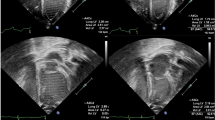Abstract
Congenital heart diseases impact millions annually, with pediatric care lacking suitable risk assessment tools. This research seeks to illuminate the association between the global longitudinal strain (GLS) and the subsequent impact on postoperative outcomes, contributing to a deeper understanding of its predictive value in the pediatric population affected by congenital heart diseases. An observational, analytic, longitudinal, and prospective study was conducted from May 2022 to May 2023, including all patients under 18 undergoing heart surgery with cardiopulmonary bypass (CBP). Patients not classifiable within the Risk Adjustment for Congenital Heart Surgery were excluded. Using transesophageal echocardiography, GLS was measured pre- and post-CPB. Receiver operating characteristic curve analysis determined GLS cut-off points for 30-day mortality risk, using Youden's method for optimal sensitivity and specificity. Bivariate and multivariate analysis identified the relationships between clinical variables. Eighty-nine patients undergoing congenital heart surgery were included. Fifteen deaths occurred. The area under the curve (AUC) for each GLS classification (pre, post, index) demonstrated effective discriminatory capacity (> 0.70) in predicting 30-day mortality. Pre-CBP GLS showed the strongest predictive power (AUC 0.833, IQR: 0.731 − 0.936) with a cut-off point of 12. Values lower than the cut-off point of pre-CPB GLS correlated with increased vasoactive-inotropic Scores and longer mechanical ventilation. GLS measurement is a reproducible method for assessing ventricular function in pediatric heart surgery, showing potential as a prognostic tool. This study marks the initial effort to establish cut-off points for preoperative GLS, postoperative GLS, and the strain index.



Similar content being viewed by others
Data Availability
No datasets were generated or analysed during the current study.
References
Sandoval N, Kreutzer C, Jatene M, Sessa TD, Novick W, Jacobs JP et al (2010) Pediatric cardiovascular surgery in South America. World J Pediatr Congenital Heart Surg 1(3):321–327. https://doi.org/10.1177/2150135110381391
Ji D, Goudy SL, Raval MV, Raol N (2019) Pediatric surgical risk assessment tools: a systematic review. J Surg Res 234:277–282. https://doi.org/10.1016/j.jss.2018.09.051
Abuelkasem E, Wang DW, Omer MA, Abdelmoneim SS, Howard-Quijano K, Rakesh H et al (2019) Perioperative clinical utility of myocardial deformation imaging: a narrative review. Br J Anaesth 123(4):408–420. https://doi.org/10.1016/j.bja.2019.04.065
Avitabile CM, Wang Y, Zhang X, Griffis H, Saavedra S, Adams S, Mercer-Rosa L (2020) Right ventricular strain, brain natriuretic peptide, and mortality in congenital diaphragmatic hernia. Ann Am Thorac Soc 17(11):1431–1439. https://doi.org/10.1513/annalsats.201910-767oc
Trivedi SJ, Altman M, Stanton T, Thomas L (2019) Echocardiographic strain in clinical practice. Heart Lung Circ 28(9):1320–1330. https://doi.org/10.1016/j.hlc.2019.03.012
Wakefield BJ, Artis AS, Alfirevic A, Sale S, Duncan AE (2022) Post-cardiopulmonary bypass longitudinal strain provides higher prognostic ability than baseline strain or change in strain. Ann Card Anaesth 25(4):505–513. https://doi.org/10.4103/aca.aca_295_20
Park JJ, Park JB, Park JH, Cho GY (2018) Global longitudinal strain to predict mortality in patients with acute heart failure. J Am Coll Cardiol 71(18):1947–1957. https://doi.org/10.1016/j.jacc.2018.02.064
Boer JM, Kuipers IM, Klitsie LM, Blom NA, Harkel ADJ (2017) Decreased biventricular longitudinal strain shortly after congenital heart defect surgery. Echocardiography 34:446–452
Levy PT, Machefsky A, Sanchez AA, Patel MD, Rogal S, Fowler S et al (2015) Reference ranges of left ventricular strain measures by two-dimensional speckle-tracking echocardiography in children: a systematic review and meta-analysis. J Am Soc Echocardiogr. https://doi.org/10.1016/j.echo.2015.11.016
Frogoudaki AA, Pantelakis I, Bistola V, Kroupis C, Birba D, Ikonomidis I, Alexopoulos D, Filippatos G, Parissis J (2020) Global longitudinal strain of the systemic ventricle is correlated with plasma galectin-3 and predicts major cardiovascular events in adult patients with congenital heart disease. Medicina (Kaunas) 56(6):305. https://doi.org/10.3390/medicina56060305
Diller GP, Radojevic J, Kempny A, Alonso-Gonzalez R, Emmanouil L, Orwat S, Swan L, Uebing A, Li W, Dimopoulos K, Gatzoulis MA, Baumgartner H (2012) Systemic right ventricular longitudinal strain is reduced in adults with transposition of the great arteries, relates to subpulmonary ventricular function, and predicts adverse clinical outcome. Am Heart J 163(5):859–866. https://doi.org/10.1016/j.ahj.2012.01.038
Perdreau E, Séguéla PE, Jalal Z, Perdreau A, Mouton JB, Nelson-Veniard M, Guillet E, Iriart X, Ouattara A, Roubertie F, Mauriat P, Thambo JB (2016) Postoperative assessment of left ventricular function by two-dimensional strain (speckle tracking) after paediatric cardiac surgery. Arch Cardiovasc Dis 109(11):599–606. https://doi.org/10.1016/j.acvd.2016.03.005
Pletzer SA, Atz AM, Chowdhury SM (2019) The relationship between pre-operative left ventricular longitudinal strain and post-operative length of stay in patients undergoing arterial switch operation is age dependent. Pediatr Cardiol 40(2):366–373. https://doi.org/10.1007/s00246-018-2018-1
Author information
Authors and Affiliations
Contributions
All authors contributed to the study's conception and design. Material preparation, data collection, and analysis were performed by Sofía Melo, Sergio Alzate, Santiago Pedroza, Richard Rivera, and Gustavo Cruz. The first draft of the manuscript was written by Sofía Melo, Sergio Álzate, Santiago Pedroza, and Gustavo Cruz. and all authors commented on previous versions of the manuscript. All authors read and approved the final manuscript.
Corresponding author
Ethics declarations
Competing interests
The authors declare no competing interests.
Additional information
Publisher's Note
Springer Nature remains neutral with regard to jurisdictional claims in published maps and institutional affiliations.
Rights and permissions
Springer Nature or its licensor (e.g. a society or other partner) holds exclusive rights to this article under a publishing agreement with the author(s) or other rightsholder(s); author self-archiving of the accepted manuscript version of this article is solely governed by the terms of such publishing agreement and applicable law.
About this article
Cite this article
Melo, S., Alzate-Ricaurte, S., Pedroza, S. et al. Optimal Global Longitudinal Strain Thresholds for Pediatric Heart Surgery: Insights from a University Hospital. Pediatr Cardiol 45, 780–786 (2024). https://doi.org/10.1007/s00246-024-03437-5
Received:
Accepted:
Published:
Issue Date:
DOI: https://doi.org/10.1007/s00246-024-03437-5




